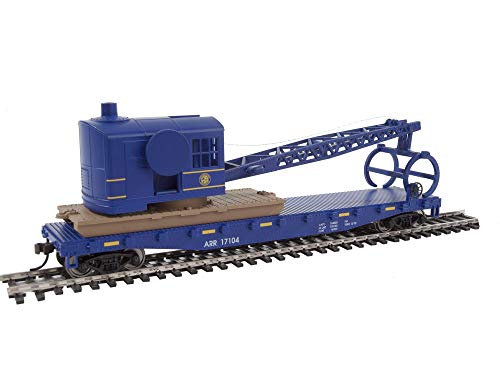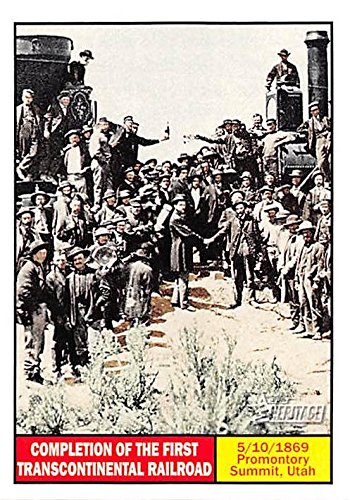Starting around 1960 Trains started listing top speeds on rail lines. Interesting to see those numbers. I am skimming the June 1966 as I type this. I should have mentioned this the first time the list was published. Given the legal complaint against NS re: Crescent it is worth noting the old SR was topping out at 65 MPH versus other RRs hitting over 80 MPH, and it was not for many miles at 65 MPH.
You are using an out of date browser. It may not display this or other websites correctly.
You should upgrade or use an alternative browser.
You should upgrade or use an alternative browser.
Interesting facts and notes in old railroad magazines
- Thread starter McLeansvilleAppFan
- Start date

Help Support Amtrak Unlimited Discussion Forum:
This site may earn a commission from merchant affiliate
links, including eBay, Amazon, and others.
Trains, July 1966. Page 14.
GONE BY 1976?: President B. F. Biaggini of Southern Pacific thinks that passenger trains will be a lingering memory in approximately 10 years and says that 125 mph speedsters, such as Japan's new Bullet Line operates, could not reverse the trend here
GONE BY 1976?: President B. F. Biaggini of Southern Pacific thinks that passenger trains will be a lingering memory in approximately 10 years and says that 125 mph speedsters, such as Japan's new Bullet Line operates, could not reverse the trend here
Wishful thinking on his part?Trains, July 1966. Page 14.
GONE BY 1976?: President B. F. Biaggini of Southern Pacific thinks that passenger trains will be a lingering memory in approximately 10 years and says that 125 mph speedsters, such as Japan's new Bullet Line operates, could not reverse the trend here
jis
Permanent Way Inspector
Staff member
Administator
Moderator
AU Supporting Member
Gathering Team Member
Well, there were many on at least one side of the aisle who voted for the Railpax Bill with a nod nod wink wink understanding that the whole thing will fail within five years. So Biagginni was not the only person suffering from that delusion, and it is quite possible that many from that era are still smarting from the fact that their dreams have failed to come to fruition. That is possibly the basis for at least a segment of the completely irrational (in my opinion) opposition to Amtrak today.Trains, July 1966. Page 14.
GONE BY 1976?: President B. F. Biaggini of Southern Pacific thinks that passenger trains will be a lingering memory in approximately 10 years and says that 125 mph speedsters, such as Japan's new Bullet Line operates, could not reverse the trend here
That was one of my favorite articles by editor Morgan. He was an excellent writer and some of his vignettes such as ‘After Midnight’ were almost poetic.Trains, May 1966. Page 53.
I will just cut and paste a picture of the screen clipping. I have not read the article yet but will at some point soon.
View attachment 38053
Last edited:
I suspect that Biaggini was referring to the mid-1960's Stanford Research Institute study that projected the end of intercity rail passenger service to come in the 1970's. That the SP paid for the study, done at an entity named for the son of one of the company's founders, struck some editorialists as unsurprising. Presumably it was done to use as evidence in train-off cases that were piling up.Well, there were many on at least one side of the aisle who voted for the Railpax Bill with a nod nod wink wink understanding that the whole thing will fail within five years. So Biagginni was not the only person suffering from that delusion, and it is quite possible that many from that era are still smarting from the fact that their dreams have failed to come to fruition. That is possibly the basis for at least a segment of the completely irrational (in my opinion) opposition to Amtrak today.

$20.99
$27.98
Walthers Trainline HO Scale Model Flatcar with Logging Crane - Alaska Railroad 17104, Blue
Amazon.com

$12.54
$14.75
TSA Approved Cable Luggage Locks, Re-settable Combination with Alloy Body, Black 2 Locks.
Forge Life LLC

$4.00
Completion of the First Transcontinental Railroad trading card (Promontory Summit Utah, 5/10/1869) 2009 Topps Heritage #113
Autograph Warehouse (AW Authentic)

$21.75
Scenes Along The Oversea Railroad - Key West Extension Florida - 1919 Curt Teich Souvenir Postcard Folder #1039
grinvideoproductions
cirdan
Engineer
- Joined
- Mar 30, 2011
- Messages
- 3,852
I don't think there are many active politicians or businessmen left today who would have been part of that nod nod wink wink agreement, and if there are they would have been pretty junior back then and hardly had much skin in the game. Any persisting disillusion or wound-licking was at best passed down through word of mouth. As neither politicians nor executives are known for their interest in things that happened before their time, I think it is safe to say that this hurt plays no role in today's politics.Well, there were many on at least one side of the aisle who voted for the Railpax Bill with a nod nod wink wink understanding that the whole thing will fail within five years. So Biagginni was not the only person suffering from that delusion, and it is quite possible that many from that era are still smarting from the fact that their dreams have failed to come to fruition. That is possibly the basis for at least a segment of the completely irrational (in my opinion) opposition to Amtrak today.
Why there are people who hate Amtrak is still a legitimate question of course.
caravanman
Engineer
There seem to be one or two of the above who post here on A.U. methinks?Why there are people who hate Amtrak is still a legitimate question of course.
cirdan
Engineer
- Joined
- Mar 30, 2011
- Messages
- 3,852
To be fair though, if Amtrak hadn't stepped in I doubt any passenger trains would have survived. The railroads would have mismanaged them to the point that abandonment would have appeared the only reasonable option.I suspect that Biaggini was referring to the mid-1960's Stanford Research Institute study that projected the end of intercity rail passenger service to come in the 1970's. That the SP paid for the study, done at an entity named for the son of one of the company's founders, struck some editorialists as unsurprising. Presumably it was done to use as evidence in train-off cases that were piling up.
Bostontoallpoints
Service Attendant
If you look at this map beginning in 1962 onwardsTo be fair though, if Amtrak hadn't stepped in I doubt any passenger trains would have survived. The railroads would have mismanaged them to the point that abandonment would have appeared the only reasonable option.
I would have had the same conclusion. I remember the big Amtrak cuts of 1979 and thought it was only a matter of time that Amtrak would just be NEC and a couple of commuter routes our of Chicago and LA.
Bostontoallpoints
Service Attendant
Look what Canada did to their passenger rail from 1980 to 2024.
https://www.arcgis.com/apps/instant/media/index.html?appid=49cce9647b164c43aa5c373f05290c78
https://www.arcgis.com/apps/instant/media/index.html?appid=49cce9647b164c43aa5c373f05290c78
If you look at this map beginning in 1962 onwards
I would have had the same conclusion. I remember the big Amtrak cuts of 1979 and thought it was only a matter of time that Amtrak would just be NEC and a couple of commuter routes our of Chicago and LA.
The atmosphere at the time, especially after the 1967 removal of the Railway Mail Service on most routes, was that disappearance was inevitable. That included the NEC, except for commute services. The Stanford study, which was widely publicized, pointed in that direction. What was missing in many discussions? Alternatives. NARP was created to fill that gap.
Trains February 1968
ARRIVALS & DEPARTURES
SORRY ABOUT THAT; Kansas City Southern,the "We Have No Intention of Going Out of the Passenger Business" road [page 40, November 1967 TRAINS] , has filed to discontinue all passenger service because of losses which have been accelerating since 1965, and discontinuance of its last RPO's in early 1968. Says President William Deramus III: "We deeply regret the situation which brings about this action. (We, too, have loved the passenger train!)."
ARRIVALS & DEPARTURES
SORRY ABOUT THAT; Kansas City Southern,the "We Have No Intention of Going Out of the Passenger Business" road [page 40, November 1967 TRAINS] , has filed to discontinue all passenger service because of losses which have been accelerating since 1965, and discontinuance of its last RPO's in early 1968. Says President William Deramus III: "We deeply regret the situation which brings about this action. (We, too, have loved the passenger train!)."
And thanks to this very article, in September 1967 when I took my big trip "back East" from Portland to Chicago and St. Louis, I dropped off the North Coast Limited in Minneapolis and caught the Morning Zephyr to Chicago. In April 1970 I rode the Rheingold. Unfortunately, I never got to the rest of this list!Trains May 1967. Fastest world trains (followed by a list of fastest American trains.)
View attachment 38105
A short while later, the NCL (and the Empire Builder) were combined with the Morning Zephyr eastbound., and the Afternoon Zephyr westbound….And thanks to this very article, in September 1967 when I took my big trip "back East" from Portland to Chicago and St. Louis, I dropped off the North Coast Limited in Minneapolis and caught the Morning Zephyr to Chicago. In April 1970 I rode the Rheingold. Unfortunately, I never got to the rest of this list!
I used to sometimes jump off a long distance train in Washington, DC, or Albany, NY and catch a Metroliner or an Empire regional on to New York City, if the opportunity presented itself, and I was in a hurry. Sometimes could save over an hour…
cirdan
Engineer
- Joined
- Mar 30, 2011
- Messages
- 3,852
would your ticket have been recognized, or would you buy a separate ticket?I used to sometimes jump off a long distance train in Washington, DC, or Albany, NY and catch a Metroliner or an Empire regional on to New York City, if the opportunity presented itself, and I was in a hurry. Sometimes could save over an hour…
Neither, I had an employee passwould your ticket have been recognized, or would you buy a separate ticket?



















































